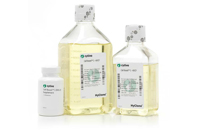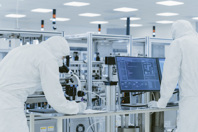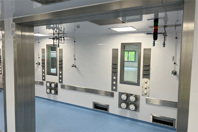INSIGHTS ON DRUG DEVELOPMENT
-
Boosting In Vitro Toxicology Testing With Organ-Chips
Discover how Organ-Chips are enhancing preclinical testing, minimizing toxicity issues, and streamlining clinical trials for enhanced safety and efficiency.
-
Explore The Emulate Organ-Chip Portfolio
Uncover how these state-of-the-art Organ-Chip technologies can elevate your research and provide deeper insights into human physiology and therapeutic responses.
-
The Innovative Flow-Through Solution For Continuous Viral Inactivation
Discover how a novel flow-through incubator enables precise, scalable low-pH virus inactivation with narrow residence time distribution and high log reduction value to support continuous bioprocessing.
-
Breaking The Chains Of Conventional Drug Research Models
Gain insight into the limitations of conventional research models, how Organ-Chips are helping researchers bridge the translation gap and overcome pervasive barriers in drug development, and more.
-
Cell Culture Automation Of The 3D Cancer Spheroid Assay3/24/2025
Discover how automated 3D cell culture methods enhance efficiency and consistency in high-throughput drug screening to accelerate the discovery of new anti-cancer therapies.
-
Advancing Precision Medicine With Patient-On-A-Chip3/8/2024
Emulate and Cedars-Sinai Medical Center have partnered to develop a Patient-on-a-Chip program that combines their stem cell expertise and Organs-on-Chips technology to advance precision medicine.
-
Take Action On PFAS To Protect Your Critical Processes9/18/2025
PFAS restrictions are tightening, but a full ban could disrupt critical industries lacking alternatives, such as pharmaceutical manufacturing. Learn where PFAS use remains indispensable.
-
Leveraging Optimized Transient Expression For Material Generation And Early Stage Insight7/23/2024
By using an optimized transient transfection platform, drug developers can accelerate their characterization and early development activities, facilitating continuity for a drug's scale-up.
-
Improving API Solubility With Mesoporous Silica6/5/2025
Poor solubility of active pharmaceutical ingredients can hinder drug effectiveness. Learn how innovative formulation strategies enhance solubility and bioavailability to improve therapeutic outcomes for challenging drug candidates.
DRUG DEVELOPMENT SOLUTIONS
-
Quickly address critical formulation issues and optimizing performance. Explore services for small molecules and synthetic peptides across oral, topical, rectal, and parenteral routes.
-
Support high-yield viral vector production with media designed for transfection efficiency, scalability, and reduced aggregation in HEK293 cells, ideal for AAV and LV workflows.
-
Gain human-relevant insights with patient-derived assay-ready organoids.
-
Learn about a manufacturing site with over 35 years of expertise in bioconjugation, APIs, excipients, and adjuvants manufacturing that helps clients accelerate drug development programs worldwide.
-
Revolutionizing Global mRNA Production: Germfree's Innovative Cleanrooms Drive Manufacturing Success
Cleanroom requirements for mRNA manufacturing encompass stringent particle control, temperature and humidity management, solvent management and robust contamination prevention strategies. Germfree’s advanced cleanroom solutions address these challenges, ensuring seamless equipment integration, process adaptability, and compliance with regulatory standards. Their tailored mobile and modular facilities support the emerging trend for localized vaccine production, empowering biopharmaceutical companies to harness the transformative potential of mRNA technology in a rapidly advancing field, and ultimately contributing to global immunization efforts.














